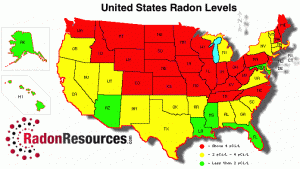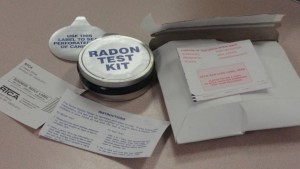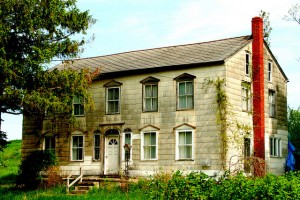Ed Petterson and his wife Jane found that their dream home in Nashville, Tennessee may not be such a blessing after all.
“We wanted something quiet, serene and out of the way, and it had a nice view and good acoustics,” said Petterson, describing a home that was absolutely everything he and his wife had always wanted.
Unfortunately, that dream state didn’t last long.
“I started to get some symptoms, really heavy ringing in my ear and my brain and sinuses. [When we moved in] we forgot to test for Radon and we tested for radon and boom it was off the charts. That went anywhere from a low of 417 to 537.”
Radon Gas Exposure is Extremely Hazardous
Those levels are extremely high, hundreds of picocuries above the recommended action limit at 4.0 pCi/L. For reference, the US EPA has set an official action limit at 4.0 pCi/L, which means any homes at or above that should have a mitigation system installed immediately to ventilate the deadly gas. At that level (4.0 pCi/L) it’s roughly the equivalent of smoking a half a pack of cigarettes per day. For every additional 15 pCi/L added, that’s another full pack of cigarettes. In the Petterson family’s case, exposure to 537 pCi/L would have been equal to smoking just over 35 packs of cigarettes per day. Hopefully, we don’t have to explain how insane that is.
Keith Phillips of Franklin Environmental Services says they are the highest levels his company has seen in about five years.
“That is like a coal mine,” said Phillips. “[Those are some] extreme levels of radon.”
Radon is an odorless, colorless and tasteless gas that can creep into any home. It’s produced as a natural decay product by elements such as Uranium, which can be commonly found in the soil and rock underneath our feet. Once produced, the dense radon gas seeps into homes through cracks in the foundation, walls and flooring. It then collects in great amounts, causing severe health issues one of the most common of which is lung cancer.
In fact, more than 21,000 Americans die each year from radon-induced lung cancer. Radon gas happens to be the second leading cause of lung cancer in many countries over, including the US, Canada and the UK.
Radon Gas is More Common Thank You Think
 It’s a widespread problem too, contrary to popular belief. Because radon occurs naturally, it can exist anywhere and seep into any home. It is estimated that one out of every fifteen homes in the United States have elevated levels of radon gas within.
It’s a widespread problem too, contrary to popular belief. Because radon occurs naturally, it can exist anywhere and seep into any home. It is estimated that one out of every fifteen homes in the United States have elevated levels of radon gas within.
In the open air it’s not a problem, however in small spaces where the gas is concentrated it can cause severe harm to the body and lungs.
Dr. John Benitez, managing director of the Poison Center at Vanderbilt University Medical Center, has confirmed that prolonged exposure to the deadly gas can affect your health in some major ways.
“Taking a whiff of it in your house by itself is not a problem. If you continue breathing that high concentration of Radon gas over time will develop radioactivity on your lungs.”
Particles called radon daughters are inhaled and then stick to the inner linings of your lungs, where the continue to undergo radioactive decay. Over time, this causes the cells inside the lungs to become cancerous.
How Do You Prevent Problems With Radon Gas?
 Wondering what the best way to prevent such a thing is? Have your home tested for the presence of radon gas, and if elevated levels are discovered hire an experienced professional to install a mitigation system.
Wondering what the best way to prevent such a thing is? Have your home tested for the presence of radon gas, and if elevated levels are discovered hire an experienced professional to install a mitigation system.
You can purchase a DIY testing kit at any local hardware store or online. If you don’t want to bother with the process yourself, you can also hire a professional to test your home for you.
WSMV Nashville — the news provider that originally broke the story — mistakenly claims that radon testing and mitigation is costly, with the Petterson family having spent thousands of dollars on both. While that estimate may be true — if not a bit exaggerated — the price of a few tests and mitigation system can hardly outweigh the cost of lung cancer should one eventually contract it from prolonged exposure. Not to mention the serious health implications of lung cancer, which has one of the highest mortality rates of any form of cancer. Let’s just say, you don’t want it.
Radon mitigation systems generally cost anywhere from $1,400 – $2,500. Keep in mind, radon professionals you hire should always be certified to conduct their business. If they are not nationally certified, then don’t hire them to do the work!
You can find more information about radon, testing and even mitigation here at Radon Resources.



